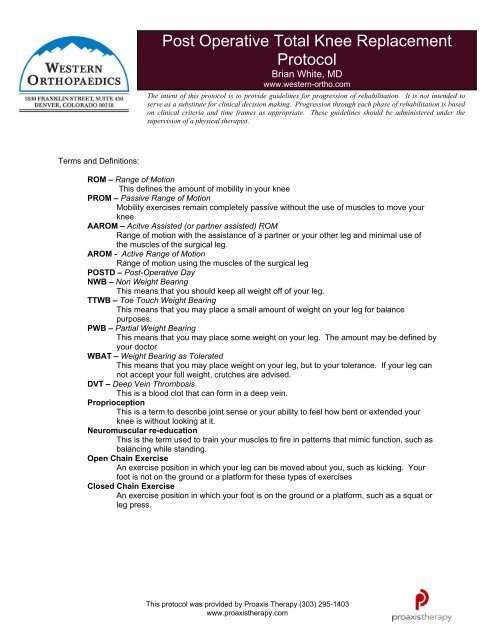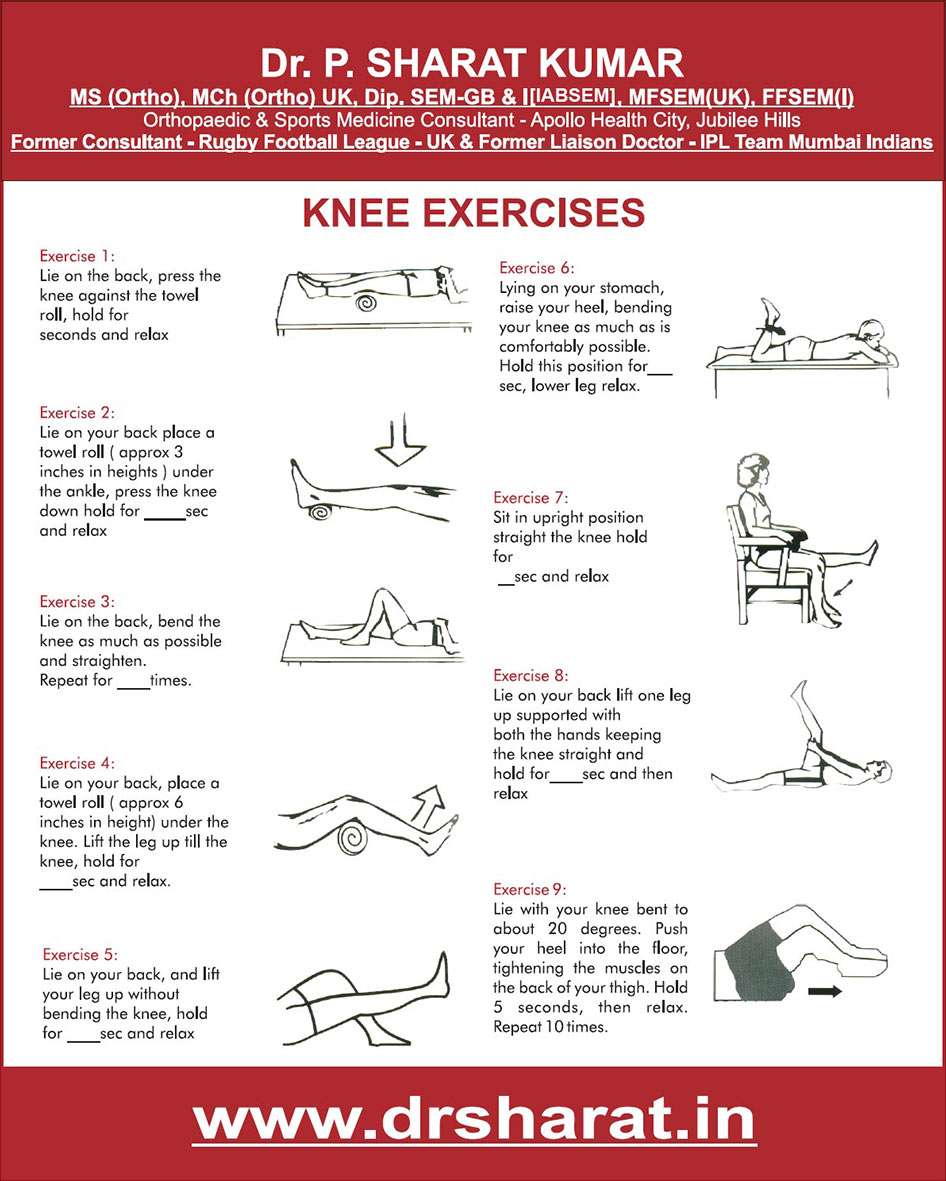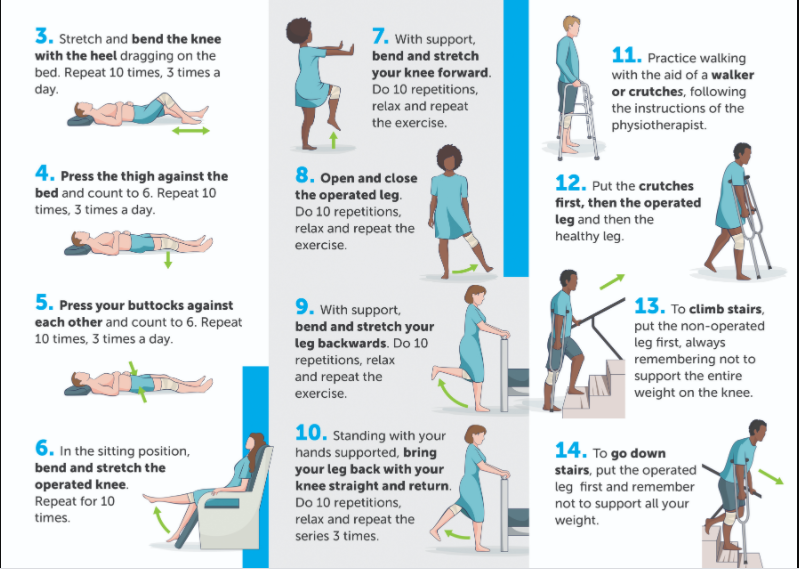Circulation Exercise: Gluteal Sets
Lie on your back with your legs straight. Squeeze buttock together and tighten buttocks muscles. Do NOT hold your breath.
- Repeat 10 times .
- Do 2 sets a day.
Gluteal Sets
Lie on your back. Bend your surgical knee by sliding your heel toward your buttocks.
- Repeat 10 times .
- Do 2 sets a day.
You may be instructed to pull on a bed sheet hooked around your foot to help you slide your heel.
Heel Slides
How Can A Physical Therapist Help
The physical therapist is an integral part of the team of health care professionals who help people receiving a total knee replacement regain movement and function, and return to daily activities. Your physical therapist can help you prepare for and recover from surgery, and develop an individualized treatment program to get you moving again in the safest and most effective way possible.
Pain Or Swelling After Exercise
You may experience knee pain or swelling after exercise or activity. You can relieve this by elevating your leg and applying ice wrapped in a towel. If you use ice, it should be placed on the knee for 20 minutes and then removed for 20 minutes this sequence should be repeated for about 2 hours.
Exercise and activity should consistently improve your strength and mobility. If you have any questions or problems, contact your orthopaedic surgeon or physical therapist.
Read Also: What Causes Knee Pain On The Inner Side
As You Begin To Recover
The goal of the first 2 weeks of recovery is to manage pain, decrease swelling, heal the incision, restore normal walking, and initiate exercise. Following those 2 weeks, your physical therapist will tailor your range-of-motion exercises, progressive muscle-strengthening exercises, body awareness and balance training, functional training, and activity-specific training to address your specific goals and get you back to the activities you love!
Range-of-motion exercises. Swelling and pain can make you move your knee less. Your physical therapist can teach you safe and effective exercises to restore movement to your knee, so that you can perform your daily activities.
Strengthening exercises. Weakness of the muscles of the thigh and lower leg could make you need to still use a cane when walking, even after you no longer need a walker or crutches. Your physical therapist can determine which strengthening exercises are right for you.
Body awareness and balance training. Specialized training exercises help your muscles “learn” to respond to changes in your world, such as uneven sidewalks or rocky ground. When you are able to put your full weight on your knee without pain, your physical therapist may add agility exercises and activities using a balance board that challenge your balance and knee control. Your program will be based on the physical therapists examination of your knee, on your goals, and on your activity level and general health.
Three To Six Weeks After Your Knee Replacement

As you gain strength, youll rely lessor not at allon assistive devices such as canes.
Often, at this point, more low-impact activities may be introduced into your exercise regimen. In addition to walking, this includes swimming or riding a stationary bike.
Many of the exercises above will continue. Knee bends will concentrate on the goal of bending your knee to 120 degrees.
At this point, many are able to complete basic household chores and slowly get back to daily activities. If you have an office job or a job that doesnt require heavy lifting or climbing, you may be able to return to work.
Also Check: How Do I Treat Knee Pain
Home And Outpatient Physical Therapy
If you are sent home, you may choose to have a home care PT visit you. This option is usually for people who can’t travel to an outpatient physical therapy center.
Your goal for home physical therapy is to make sure you can move safely in your home. You will keep working on knee ROM and strength. Walking and stair climbing may also be a part of your home physical therapy.
Scar tissue will form as your incision heals. Your PT may use gentle scar tissue massage and mobilization to help improve the mobility of your incision. This can help the skin and other tissues around your knee move more freely.
If you can travel to a physical therapy center, you may begin outpatient physical therapy. There, you will keep improving your knee ROM. You should be able to bend your knee to a 90 degree angle by the end of week 2.
What Kind Of Physical Therapist Do I Need
Although all physical therapists are prepared through education and experience to treat people who have a total knee replacement surgery, you may want to consider:
- A physical therapist who is experienced in treating people with orthopedic, or musculoskeletal, problems
- A physical therapist who is a board-certified clinical specialist or who has completed a residency or fellowship in orthopedic physical therapy, giving the physical therapist advanced knowledge, experience, and skills that may apply to your condition
You can find physical therapists who have these and other credentials by using Find a PT, the online tool built by the American Physical Therapy Association to help you search for physical therapists with specific clinical expertise in your geographic area.
General tips when you’re looking for a physical therapist:
- Get recommendations from family and friends or from other health care providers.
- When you contact a physical therapy clinic for an appointment, ask about the physical therapist’s experience in helping people with knee replacements.
During your first visit with the physical therapist, be prepared to describe your symptoms in as much detail as possible, and say what makes your symptoms worse.
Don’t Miss: What Is The Best Artificial Knee
How Long Do You Need Physical Therapy After A Knee Replacement
Of course, this will vary from patient to patient, depending upon your individual situation. However, in general, you can expect around 3 to 4 weeks of formal physical therapy from our experts.
Dr. Christian Eccles, our Fellowship-trained Hip and Knee Replacement surgeon, says Therapy is vital to obtaining the best functional outcome possible after a knee replacement as it can aid in pain control, improve motion, and expedite recovery.
Our patients typically are able to drive within 2 to 4 weeks, go back to work in 6 to 8 weeks, and golf in 6 to 12 weeks.
Your physical therapy exercises that you learn should be continued on your own for a minimum of two months after your surgery. They may also recommend some additional exercises such as riding a stationary bicycle after this period to help keep your knee flexible. This will also help build your muscle tone.
A Physical Therapy Timeline
If youre having physical therapy in Myrtle Beach or in any of the surrounding Horry County areas we serve, you will have an individualized treatment plan tailored to your specific situation. Therefore, there may be some slight variations of this timeline. However, it should provide you with an idea of how long youll need physical therapy after a knee replacement.
Read Also: What Are Bone Spurs In Your Knee
Stair Climbing And Descending
Stair climbing is an excellent strengthening and endurance activity that also requires flexibility.
- At first, you will need a handrail for support and will be able to go only one step at a time.
- Always lead up the stairs with your good knee and down the stairs with your operated knee. Remember, “up with the good” and “down with the bad.”
- You may want to have someone help you negotiate stairs until you have regained most of your strength and mobility.
- Do not try to climb steps higher than the standard height and always use a handrail for balance.
- As you become stronger and more mobile, you can begin to climb stairs foot over foot.
Stair climbing and descending using a crutch
Rehabilitation Protocols Following Total Knee Arthroplasty: A Review Of Study Designs And Outcome Measures
Iciar M. Dávila Castrodad, Thea M. Recai, Megha M. Abraham, Jennifer I. Etcheson, Nequesha S. Mohamed, Armin Edalatpour, Ronald E. Delanois
Rubin Institute for Advanced Orthopedics, Center for Joint Preservation and Replacement, Sinai Hospital of Baltimore , USA
Contributions: Conception and design: IM Dávila Castrodad, NS Mohamed, TM Recai, MM Abraham Administrative support: NS Mohamed, JI Etcheson, RE Delanois Provision of study materials or patients: JI Etcheson, RE Delanois Collection and assembly of data: IM Dávila Castrodad, TM Recai, MM Abraham, A Edalatpour Data analysis and interpretation: IM Dávila Castrodad, TM Recai, MM Abraham, NS Mohamed, A Edalatpour Manuscript writing: All authors Final approval of manuscript: All authors.
Correspondence to:
Keywords: Total knee arthroplasty postoperative rehabilitation physical therapy physiotherapy
Submitted Mar 28, 2019. Accepted for publication Aug 02, 2019.
doi: 10.21037/atm.2019.08.15
You May Like: Can Gout Get In Your Knee
Sitting Unsupported Knee Bends
- While sitting at bedside or in a chair with your thigh supported, bend your knee as far as you can until your foot rests on the floor.
- With your foot lightly resting on the floor, slide your upper body forward in the chair to increase your knee bend. Hold for 5 to 10 seconds.
- Straighten your knee fully.
- Repeat several times until your leg feels fatigued or until you can completely bend your knee.
- This exercise should take 3 minutes.
Sitting unsupported knee bend
Advanced Exercises And Activities

Once you have regained independence for short distances and a few steps, you may increase your activity. The pain of your knee problems before surgery and the pain and swelling after surgery have weakened your knee. A full recovery will take several months. The following exercises and activities will help you recover fully.
Read Also: What Do They Replace Your Knee With
High Velocity & High Intensity Exercise
Rehabilitation protocol
As individuals age, several neuromotor changes occur, which leads to skeletal muscle weakness and reduced power. In TKA recipients, muscular strength and power decrease by at least 24% when compared to the contralateral side . Experts believe more demanding rehabilitation protocols may help overcome these deficits. Recent research focuses on rehabilitation strategies that incorporate movement velocity, a component of power. Given its preferential activation of type 2 muscle fibers, high velocity exercise is thought to improve functional mobility . This form of exercise is defined as performing a muscle contraction as quickly as possible, or in 1 second or less. In contrast to HV, a LV muscle contraction is performed in two seconds or more. Evidence indicates that HV exercises can improve static and dynamic balance while decreasing quadriceps impairment .
On the other hand, high intensity rehabilitation solely focuses on strength, defined as the contraction force. This program includes progressive resistance exercises and rapid progression to weight-bearing exercises. Several authors have expressed that the progressive strengthening and functional exercises according to clinical milestones promote positive outcomes . What is not yet known is whether a PRE-program restores function to levels comparable to healthy age-matched controls. Four Level-of-Evidence I studies regarding HV and HI exercise were analyzed in this systematic review .
Why Is Physical Therapy Important After Knee Replacement Surgery
Regaining your range of motion and strength after total knee replacement surgery is critical to regaining your ability to do the things that are important to you. You will start the following exercise program soon after your surgery. Your physical therapist will help you with the exercises initially and you will be expected to continue the exercises as instructed. As you recover, some exercises will be discontinued and others may be added. Please let your therapist or surgeon know if you are having difficulty with your exercises.
Recommended Reading: What To Wear To Hospital For Knee Surgery
Can This Injury Or Condition Be Prevented
If you have knee pain, you may be able to delay the need for surgery by working with a physical therapist to improve the strength and flexibility of the muscles that support and move the knee. This training could even help you avoid surgery altogether. Participating in an exercise program designed by a physical therapist can be one of your best protections against knee injury. And staying physically active in moderately intense physical activities and controlling your weight through proper diet might help reduce the risk of osteoarthritis of the knee getting worse.
What Is Total Knee Replacement
A total knee replacement, also known as total knee arthroplasty, involves removing the arthritic parts of the bones at the knee joint and replacing them with artificial parts. These parts consist of a metal cap at the end of the femur and a cemented piece of metal in the tibia with a plastic cap on it to allow the surfaces to move smoothly. When appropriate, the back part of the kneecap also may be replaced with a smooth plastic surface.
You May Like: How To Remove Scar Tissue From Knee
Inclusion & Exclusion Criteria
Publications were eligible for inclusion if they: examined postoperative exercise-based interventions in a rehabilitation setting they included participants who underwent primary unilateral TKA the study was performed in the United States of America, Canada, United Kingdom, or Australia and the level of evidence was III or higher based on the American Association of Orthopaedic Surgeons level of evidence classification . Studies were excluded if: they were written or published in a language other than English and the full text was not available they were systematic reviews, meta-analyses, study protocols for randomized controlled trials , feasibility or pilot studies, letters to the editor, surveys, or case reports . Two independent reviewers screened each title and abstract to determine whether the article met the inclusion and exclusion criteria. If the two reviewers agreed about the inclusion of a study, the study was selected for final analysis. If there was any doubt about a studys eligibility, a third reviewer was consulted.
Systematic review flowchart for study inclusion.
Comprehensive Physical Therapy In Myrtle Beach And Horry County To Help You After Knee Replacements
There are few things more rewarding than seeing patients return to their everyday activities without pain or discomfort. For millions of Americans, knee replacements have helped them regain the life they once enjoyed before knee pain.
Conway Medical Center has become a leader in this life-changing surgery by utilizing the latest advancements in medical technology and pain management. We offer both total and partial knee replacement procedures by leading orthopedic experts who have the extensive expertise and experience to help you.
Want to know more? Just contact us.
Don’t Miss: Do I Have Arthritis In My Knee
What Is Physical Therapy
Physical therapy is a health care service that helps you restore body movement and your physical functionality through non-invasive methods.
For example, a physical therapist may help someone learn to walk again following a stroke or injury. For those who have had a knee replacement, a physical therapist is an important part of the healthcare team. By working closely with your physical therapist, you can regain the range of motion in your leg, helping you return to the activities you once enjoyed.
Sitting Supported Knee Bends

- While sitting at your bedside or in a chair with your thigh supported, place your foot behind the heel of your operated knee for support.
- Slowly bend your knee as far as you can. Hold your knee in this position for 5 to 10 seconds.
- Repeat several times until your leg feels fatigued or until you can completely bend your knee.
- This exercise should take 2 minutes.
Sitting supported knee bend
Read Also: What Is The Procedure For Knee Replacement
Physical Therapy Guide To Total Knee Replacement
Read Time:
The knee is the most commonly replaced joint in the body. The decision to have knee replacement surgery is one that you should make in consultation with your orthopedic surgeon and your physical therapist. Usually, total knee replacement surgery is performed when people have:
- Knee joint damage due to osteoarthritis, rheumatoid arthritis, other bone diseases, or fracture that has not responded to more conservative treatment options
- Knee pain or alignment problems in the leg that cause difficulty with walking or performing daily activities, which have not responded to more conservative treatment options
Physical therapists are movement experts who improve quality of life through hands-on care, patient education, and prescribed movement. You can contact a physical therapist directly for an evaluation. To locate a physical therapist in your area, visit Find a PT.
One To Two Weeks After Surgery
During this time, physical therapy concentrates on balance, range-of-motion and strengthening exercises. This may include:
- Leg raises
- Practice getting up from a sitting position
- Knee straightening exercises
- Supported knee bendswith the goal of eventually having the knee bend to a 90-degree angle
- Walkingif you need to use a cane or walker, the physical therapist will work with you ensure youre using them properly
Recommended Reading: What’s The Best Knee Brace